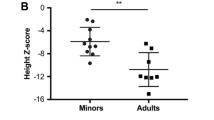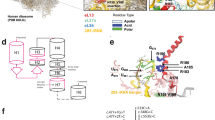Abstract
Background. Hypochondroplasia is characterised by phenotypic and genetic heterogeneity. Differentiation from other conditions with disproportionate short stature is often difficult. Objective. To determine the reliability of radiological interpretation in the diagnosis of hypochondroplasia and to evaluate the most typical skeletal abnormalities. These data were correlated with molecular findings. Materials and methods. We enrolled 21 patients with suspected hypochondroplasia based on the radiological criteria most often reported in the literature on this disease. Height, sitting height and head circumference were measured in all patients. Radiographs of the lumbar spine, left leg, pelvis and left hand were obtained. The presence of the N540K mutation in the fibroblast growth factor receptor 3 (FGFR3) gene was verified by restriction enzyme digestion. All radiographs which enabled the selection of patients were reviewed a second time by two paediatric radiologists in a blinded examination. Their results were compared. Results. Both radiologists confirmed the diagnosis in 10 out of 21 patients, while in the other 52 % of cases they excluded the disease, were uncertain or they did not agree on the final interpretation of the data. The best agreement rate was obtained in the evaluation of the lumbar spine and the legs. The radiological features of the nine patients (43 %) carrying the N540K substitution were not remarkably different from the ones reported in the patients without this mutation. Conclusion. Our study shows that the crucial skeletal regions on which to focus the diagnosis of hypochondroplasia are the lumbar spine and legs, while the pelvis and hands seem to be less characteristic. To reduce the risk of misdiagnosis, accurate radiological and clinical evaluation is needed, especially in cases without a defined genetic defect.
Similar content being viewed by others
Author information
Authors and Affiliations
Consortia
Additional information
Received: 15 November 1999 Accepted: 8 May 2000
Rights and permissions
About this article
Cite this article
Prinster, C., Maschio, M., Beluffi, G. et al. Diagnosis of hypochondroplasia: the role of radiological interpretation. Pediatric Radiology 31, 203–208 (2001). https://doi.org/10.1007/s002470000398
Issue Date:
DOI: https://doi.org/10.1007/s002470000398




